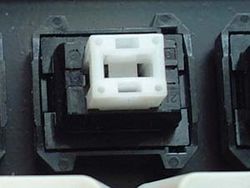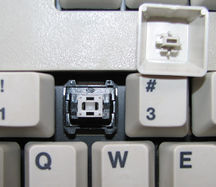Alps SKCP series
| This article requires additional photographic illustration — disassembly |
 | |
| Manufacturer | Alps Electric |
|---|---|
| Inventor | Akio Nishijima |
| Switch type | Clicky |
| Sense method | Metal leaf |
| Peak force | 60 cN |
| Total travel | 4 mm |
| Keycap mount | Alps mount |
| Patents | US4613737 (1984) |
Alps SKCP series, commonly known as "Alps plate spring", is a stacked spring switch from Alps.
Contents
History
The switch has its origin in the "Nodally Operated Push-Button Switch" design, invented by Taneo Murata and with a patent filed in 1974.[1] SKCP series, as the "SKC" implies, is a switchplate-based enhancement of the design, with a patent filed ten years later. This switch appears to slightly pre-date the introduction of the click leaf and Alps SKCM Blue.
The series name of "SKCP" is derived from a label in a Canon AP 560 typewriter.[2]
Description
The switch could be described in some ways as a simplified beam spring switch, as it uses a flat spring to generate tactility and actuate the contact mechanism. The return spring is held captive inside the slider by a block that clips into the primary slider from below. When the slider is removed, the return spring remains inside the slider. This slider/spring/block arrangement presses down onto the plate spring. The helical–plate spring pairing provides hysteresis and pretravel.
Total travel is 4 mm. Attempts to measure the plate spring snap and release points with callipers yields a snap point between 2.2 and 2.5 mm, and a release point between 1.3 and 1.6 mm, with the exact points varying from stroke to stroke. The perceptual hysteresis seems to be somewhere in the region of 1 mm, but this is hard to determine with callipers as, even using the thumbwheel to increment the switch travel and release, the kick from the plate spring is enough to cause a significant misreading. Testing with a multimeter shows however that the click and tactile feel does not directly correspond with contact operation. The actuation feedback does correspond with the actuation itself, but the contact hysteresis is much lower than the perceived hysteresis. After actuating the switch, releasing the slider a small amount will allow the switch to be "teased" (generating a resistance proportional to slider position in either direction), and after a short release distance the contacts will fully disengage. The slider can then be released significantly further before the plate spring snaps back, at which point a second click is heard. As the tests was performed on a used switch, and no documentation for the switches has been found, it is not known whether this discrepancy is due to the design or due to wear within the switch.
The slider is compatible with the same keycaps as Alps SKCL/SKCM series switches.
Early switches in IBM keyboards were PCB mounted; later ones were plate mounted. PCB mounted switches have a different lower shell from plate mounted switches. The PCB mounted variant cannot snap into a typical alps mount.
The side tabs to hold the top of the switch to the bottom are much weaker than those on Alps SKCL/SKCM. Unlike the tab on SKCC which can break, on SKCP the top of the housing is held by the bottom by small tabs which press into horizontal slits on the bottom housing. If opened incorrectly the lower housing can bend outward and not fully grip the top. This may result in keycap removal pulling the entire top of the switch off or in the worst cases, occasional return spring force ejecting the top housing.
SKCP series is generally known only for its standard momentary switch. However, the backspace key in the Canon AP500-II uses a larger, more complex-looking switch that may be double action.[3]
Keyboards
- IBM 5576-001
- IBM 5576-002
- IBM PS/55 5545T[4]
- IBM P70/P75[5]
Typewriters / Word Processors
Gallery
References
- ↑ US Patent 3899648, Taneo Murata, "Nodally Operated Push-Button Switch", filed Mar 13 1974, issued Aug 12 1975.
- ↑ 2.0 2.1 Deskthority — Canon Typewriter Keyboards
- ↑ 3.0 3.1 Deskthority — Canon AP400
- ↑ Sandy — P70 keyboard
- ↑ Deskthority — IBM PS/2 P70/P75 keyboard (ALPS Plate Springs)
External links
- Qwerters Clinic — Dissection of an Alps plate spring switch

